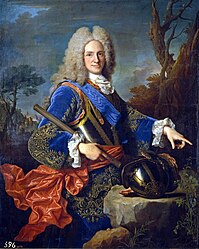Fasciculus:Felipe V de España.jpg

Mensura huius perspectionis: 478 × 599 elementa imaginalia. Aliae mensurae: 191 × 240 elementa imaginalia | 383 × 480 elementa imaginalia | 613 × 768 elementa imaginalia | 817 × 1 024 elementa imaginalia | 2 435 × 3 051 elementa imaginalia.
Sua resolutio (2 435 × 3 051 elementa imaginalia, magnitudo fasciculi: 1.59 megaocteti, typus MIME: image/jpeg)
Historia fasciculi
Presso die vel tempore fasciculum videbis, sicut tunc temporis apparuit.
| Dies/Tempus | Minutio | Dimensiones | Usor | Sententia | |
|---|---|---|---|---|---|
| recentissima | 18:24, 16 Maii 2022 |  | 2 435 × 3 051 (1.59 megaocteti) | AndrewdelaHuerta | Reverted to version as of 23:19, 21 June 2010 (UTC) |
| 19:28, 18 Iulii 2018 |  | 2 435 × 3 051 (1.09 megaocteti) | Tm | Reverted to version as of 10:37, 15 March 2016 (UTC) This is a version sourced from Museo del Prado | |
| 17:14, 18 Iulii 2018 |  | 1 530 × 1 920 (2.2 megaocteti) | Cipriano Pozoblanco | original version of Museo Nacional del Prado source=https://www.museodelprado.es/coleccion/obra-de-arte/felipe-v-rey-de-espaa/2e64f6c5-a241-4de9-bb50-3585f557ded1 | |
| 10:37, 15 Martii 2016 |  | 2 435 × 3 051 (1.09 megaocteti) | Tm | Reverted to version as of 04:07, 22 June 2010 (UTC) | |
| 08:44, 15 Martii 2016 |  | 2 352 × 2 952 (2.24 megaocteti) | Tiberioclaudio99 | Better versión and higher resolution. | |
| 04:07, 22 Iunii 2010 |  | 2 435 × 3 051 (1.09 megaocteti) | Tm | Reverted to version as of 21:20, 28 August 2009 (this image was taken by Museo del El Prado, so tis image is a faithfull reproduction of how the paiting is now, please upload your version under a new filename | |
| 23:19, 21 Iunii 2010 |  | 2 435 × 3 051 (1.59 megaocteti) | Forest~commonswiki | Better quality | |
| 21:20, 28 Augusti 2009 |  | 2 435 × 3 051 (1.09 megaocteti) | Jose Manuel 3000~commonswiki | {{Information |Description={{es|1=Retrato oficial del primer monarca de la Casa de Borbón en España, Felipe V (1683-1746). Nieto de Luis XIV (1638-1715), nació en Versalles y fue proclamado rey de España en 1700. Casó dos veces, tuvo numerosos hijos |
Nexus ad fasciculum
Ad hunc fasciculum nectit:
Usus fasciculi per inceptus Vicimediorum
Quae incepta Vici fasciculo utuntur:
- Usus in an.wikipedia.org
- Usus in ar.wikipedia.org
- Usus in arz.wikipedia.org
- Usus in ast.wikipedia.org
- Usus in azb.wikipedia.org
- Usus in az.wikipedia.org
- Usus in be.wikipedia.org
- Usus in bg.wikipedia.org
- Usus in bn.wikipedia.org
- Usus in br.wikipedia.org
- Usus in ca.wikipedia.org
- Usus in cs.wikipedia.org
- Usus in cy.wikipedia.org
- Usus in da.wikipedia.org
- Usus in de.wikipedia.org
- Usus in el.wikipedia.org
- Usus in en.wikipedia.org
View more global usage of this file.


